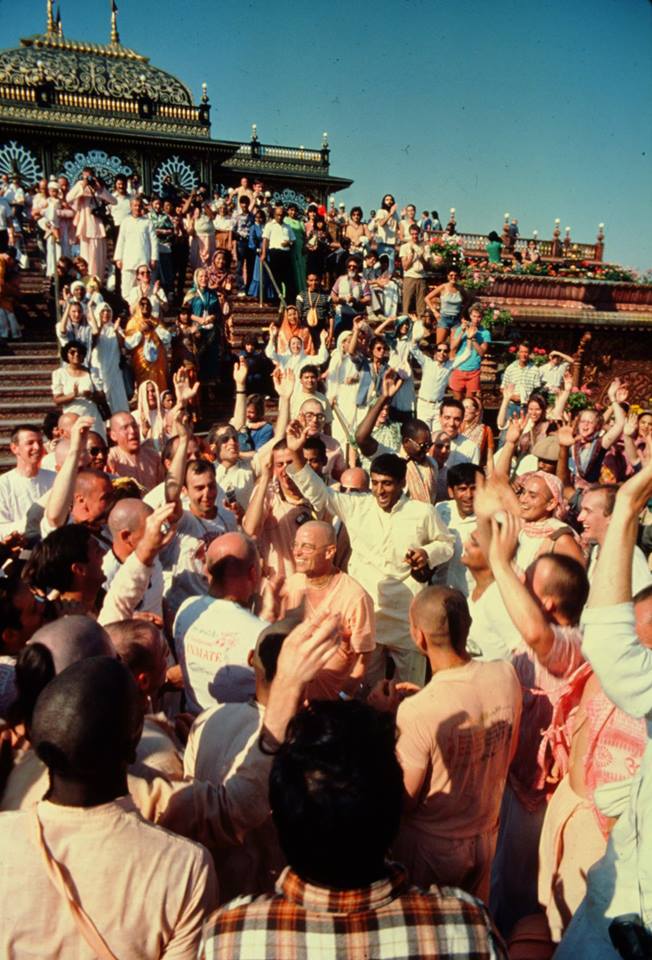
Bhaktipada (in center) and devotees having kirtan at Prabhupada's Palace of Gold, New Vrindaban, West Virginia, Labor Day Weekend (September), ca. 1982.
| Killing for Krishna The Danger of Deranged Devotion a book by Henry Doktorski Publication date: January 1, 2018. © by Henry Doktorski |

Bhaktipada: A Star in ISKCON
from the IntroductionHis Divine Grace Kirtanananda Swami Bhaktipada (Keith Gordon Ham: in center of image) was a star in ISKCON. When he traveled to Hare Krishna temples in the United States and abroad, he was idolized as a celebrity. Brahmacaris (celibate male students) especially fawned over him, eager to render some personal service. They attentively listened to his classes and darshans as if each word from Bhaktipada’s mouth was a drop of nectar falling directly from the spiritual sky. Bhaktipada was respected and admired throughout most of the ISKCON world for at least ten reasons:
(1) He was regarded as Prabhupada’s first and senior-most disciple. He bragged, “Srila Prabhupada said I was first in everything.”
(2) He was noted for his preaching and debating skills; he was considered a scholar of both the Bhagavad-gita and the Bible, and was acknowledged as undefeatable in argument.
(3) His austerities—such as rising early before sunrise, taking a cold shower even in winter, attending all the temple services, avoiding contact with women, strictly following the four regulative principles (allegedly) and eating only the barest minimum to keep body and soul together—were legendary.
(4) He was adored for his great love and affection for his spiritual master, which was poignantly exhibited when he shed profuse tears of separation on a number of occasions, such as when Prabhupada was ill or when he passed away.
(5) He was extremely charismatic. One contemporary remembered, “Not all the [ISKCON] gurus had that kind of strong personal charisma, but he did. In life sometimes you’ll meet a person that just is electric. Kirtanananda had that unnamable immensity of personal character whereby people felt kind of cowed by his presence, or very impressed, or blown away.”
(6) He established the New Vrindaban Community in Marshall County, West Virginia, and built it from next to nothing into the largest ISKCON farm community in North America.
(7) He masterminded the design and construction of Prabhupada’s Palace of Gold—billed as “The Taj Mahal of the West”—the marble and gold memorial shrine for the founder and acharya of ISKCON, His Divine Grace A. C. Bhaktivedanta Swami Prabhupada, which catapulted New Vrindaban to the attention of national and international media.
(8) More Prabhupada disciples reportedly served under Bhaktipada than under any other guru in ISKCON. By the end of 1986, only about 500 Prabhupada disciples remained active in ISKCON (3,500 had left for one reason or another), but, thirty percent (almost 150) of all Prabhupada disciples active at that time lived at New Vrindaban or its satellite centers.
(9) By 1986, he had initiated a thousand devoted disciples throughout the world, and had an army of dedicated fundraisers out on the “pick” who collected sometimes $150,000 per week, and more than $3,000,000 per year. Bhaktipada had deep pockets and he could spend his money, for the most part, however he pleased.
(10) He had a small but loyal group of ksatriya enforcers who helped maintain discipline in the community. Usually they threatened or beat up disobedient devotees; more rarely they used stronger methods to silence especially dangerous dissidents. One California devotee who had been threatened by some of New Vrindaban’s ksatriya enforcers noted, “On the ‘Goon Squad’ were a group of guys . . . that would beat the hell out of you or whatever it takes to convince people to cooperate.”
Although Bhaktipada could be ruthless to those who incurred his wrath, he was also extremely affectionate to his faithful servants. He had a cult following of over five hundred devotees who lived and worked at the community and its satellite centers in West Virginia, Pennsylvania, Ohio, Florida and New York City, and thousands more in Canada, India, Africa, Malaysia and elsewhere. Most of them did as they were told. He had power, and he was not afraid to use it. Other ISKCON gurus may not have liked Bhaktipada or his tactics, but they nonetheless admired him and coveted his wealth, power, fame and renunciation. Most wished they could be like him in many respects.
Back to: Killing for Krishna Homepage